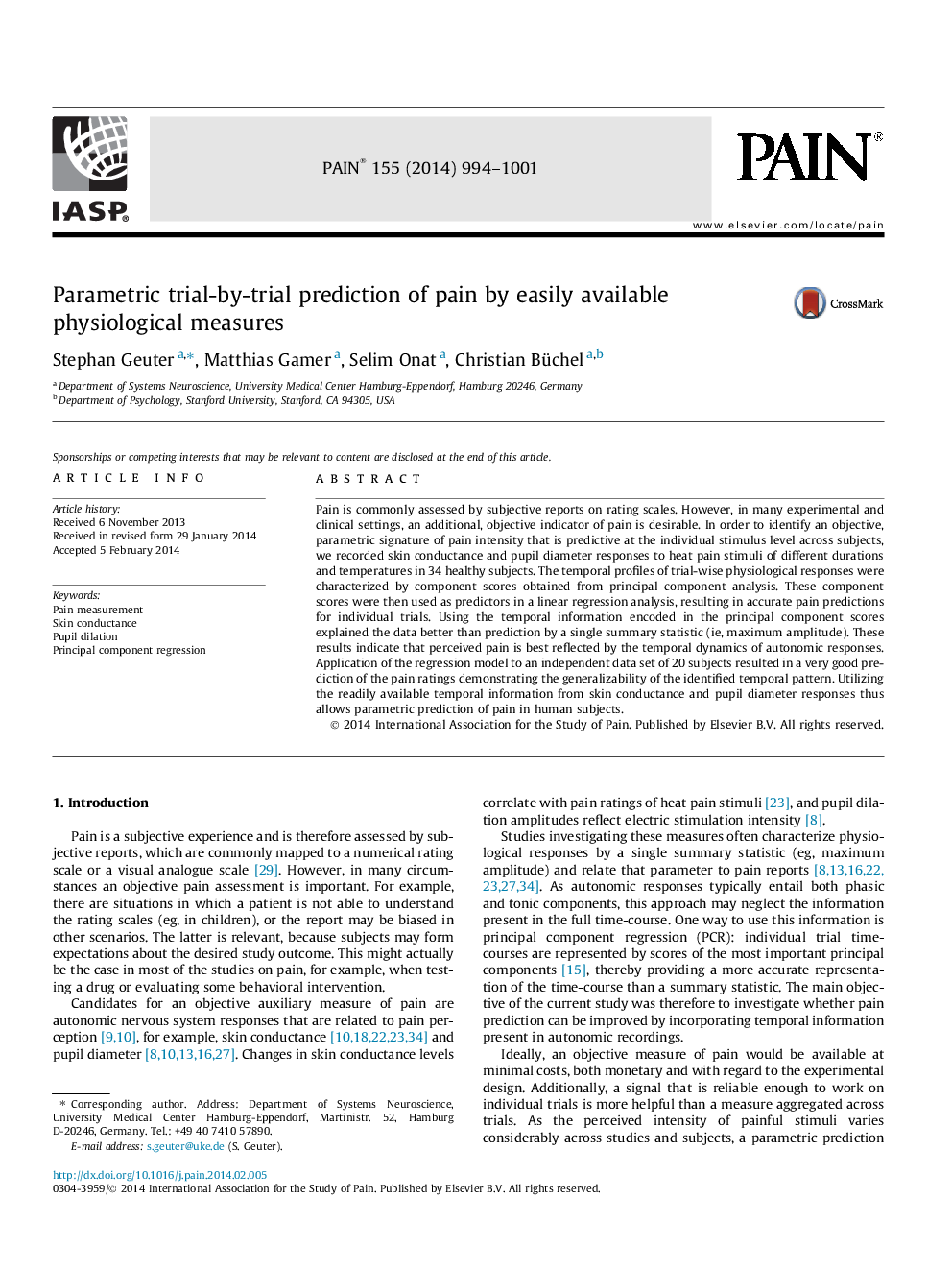| کد مقاله | کد نشریه | سال انتشار | مقاله انگلیسی | نسخه تمام متن |
|---|---|---|---|---|
| 913729 | 918342 | 2014 | 8 صفحه PDF | دانلود رایگان |
عنوان انگلیسی مقاله ISI
Parametric trial-by-trial prediction of pain by easily available physiological measures
ترجمه فارسی عنوان
پیشگویی پارامتریک درمورد فرآیند به وسیله اقدامات فیزیولوژیکی به راحتی قابل دسترسی است
دانلود مقاله + سفارش ترجمه
دانلود مقاله ISI انگلیسی
رایگان برای ایرانیان
کلمات کلیدی
اندازه گیری درد، رطوبت پوست، انعقاد دانش آموز، رگرسیون مولفه اصلی،
ترجمه چکیده
درد معمولا توسط گزارش های ذهنی در مقیاس های رتبه بندی ارزیابی می شود. با این حال، در بسیاری از شرایط آزمایشگاهی و بالینی، یک شاخص اضافی، عینی از درد مطلوب است. به منظور شناسایی یک هدف، پارامتریک امتداد شدت درد که در سطح محرک فردی در سراسر افراد پیش بینی شده است، ما ضریب هدایت پوست و پاسخ قطر دانش آموزان به تحرک درد را با طول های مختلف و درجه حرارت در 34 فرد سالم ضبط کردیم. پروفایل های زمانی از پاسخ های فیزیولوژیک محاکمه توسط نمرات جزء به دست آمده از تجزیه و تحلیل مولفه اصلی مشخص شد. سپس این نمرات جزء به عنوان پیش بینی کننده ها در تجزیه و تحلیل رگرسیون خطی مورد استفاده قرار گرفت و نتایج پیش بینی دقیق درد را برای آزمایشات فردی به دست آورد. با استفاده از اطلاعات زمانی که در نمرات اصلی مولفه کدگذاری شده است، داده ها بهتر از پیش بینی توسط یک آمار کلی خلاصه (یعنی حداکثر دامنه) توضیح داده شده است. این نتایج نشان می دهد که درد درک شده به واسطۀ دینامیک زمانی پاسخ های اتونومیک بیشتر منعکس می شود. استفاده از مدل رگرسیون به مجموعه داده های مستقل از 20 نفر منجر به پیش بینی بسیار خوب ارزیابی درد شد و نشان دهنده تعمیم الوصول الگوی زمانی شناسایی شده بود. لذا استفاده از اطلاعات زمانبندی قابل دسترس از هدایت پوست و پاسخ قطر دانش آموزان به این ترتیب امکان پیش بینی پارامتر درد در افراد انسانی را فراهم می کند.
موضوعات مرتبط
علوم زیستی و بیوفناوری
علم عصب شناسی
علوم اعصاب سلولی و مولکولی
چکیده انگلیسی
Pain is commonly assessed by subjective reports on rating scales. However, in many experimental and clinical settings, an additional, objective indicator of pain is desirable. In order to identify an objective, parametric signature of pain intensity that is predictive at the individual stimulus level across subjects, we recorded skin conductance and pupil diameter responses to heat pain stimuli of different durations and temperatures in 34 healthy subjects. The temporal profiles of trial-wise physiological responses were characterized by component scores obtained from principal component analysis. These component scores were then used as predictors in a linear regression analysis, resulting in accurate pain predictions for individual trials. Using the temporal information encoded in the principal component scores explained the data better than prediction by a single summary statistic (ie, maximum amplitude). These results indicate that perceived pain is best reflected by the temporal dynamics of autonomic responses. Application of the regression model to an independent data set of 20 subjects resulted in a very good prediction of the pain ratings demonstrating the generalizability of the identified temporal pattern. Utilizing the readily available temporal information from skin conductance and pupil diameter responses thus allows parametric prediction of pain in human subjects.
ناشر
Database: Elsevier - ScienceDirect (ساینس دایرکت)
Journal: PAIN® - Volume 155, Issue 5, May 2014, Pages 994-1001
Journal: PAIN® - Volume 155, Issue 5, May 2014, Pages 994-1001
نویسندگان
Stephan Geuter, Matthias Gamer, Selim Onat, Christian Büchel,
